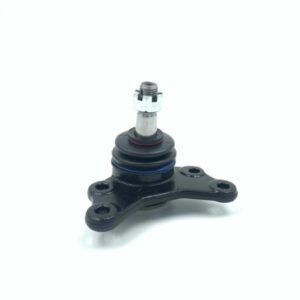A ball joint is a mechanical component used in various applications, including automotive suspension systems and other mechanical linkages. It provides a flexible connection between two components, allowing movement in multiple directions while transmitting forces and providing support.
Here are some key points about ball joints:
Design: A ball joint consists of a spherical ball-like stud or pivot and a socket or housing that contains the ball. The ball is usually made of hardened steel, and the socket is typically made of a durable material such as steel or aluminum. The ball fits into the socket, providing a pivot point with a wide range of motion.
Construction Types: There are different types of ball joints, including:
Load-Bearing Ball Joints: These ball joints support the weight of the vehicle or equipment and are commonly found in automotive suspension systems.
Non-Load-Bearing Ball Joints: These ball joints are used in linkages where the primary function is to allow movement without supporting significant loads.
Function: The primary function of a ball joint is to allow rotational and angular movement between two connected components. It enables steering movements in automotive applications and allows for smooth suspension articulation. Ball joints also help to distribute forces and loads evenly, contributing to the overall stability and performance of the system.
Lubrication: Ball joints require proper lubrication to minimize friction and wear. Lubrication helps to maintain smooth movement and prevent premature failure. Grease fittings or sealed designs are commonly used to ensure lubrication access and retention.
Wear and Maintenance: Ball joints are subject to wear over time due to the constant movement and exposure to varying forces. Signs of a worn ball joint include excessive play, clunking noises, uneven tire wear, and poor vehicle handling. Regular inspection and maintenance are important to identify and replace worn ball joints to ensure safe and reliable operation.
Replacement: When a ball joint becomes worn or damaged beyond acceptable limits, it is necessary to replace the entire joint. Replacement typically involves removing the old ball joint and installing a new one using appropriate tools and procedures. It’s essential to follow manufacturer guidelines and torque specifications during the replacement process.
Safety Considerations: Proper functioning ball joints are crucial for safe operation, especially in automotive applications. Worn or faulty ball joints can affect steering control, suspension stability, and overall vehicle handling. Regular inspections and maintenance are important for early detection and replacement of worn ball joints to ensure safe vehicle operation.
It’s important to consult the specific manufacturer’s instructions, vehicle service manuals, or seek professional assistance when working with ball joints or any suspension-related components to ensure proper installation and safety.
Here are some additional details about ball joints:
Types of Ball Joints: There are different types of ball joints used in various applications. Some common types include:
Automotive Ball Joints: These are commonly used in the suspension systems of vehicles. They allow for movement and rotation in the control arms, China ball joint suppliers connecting the wheels to the chassis. Automotive ball joints can be categorized into two main types: upper ball joints and lower ball joints.
Tie Rod Ends: Tie rod ends are a type of ball joint that connects the steering linkage to the steering knuckle. They allow for the transfer of steering inputs from the steering system to the wheels.
Universal Joints: Universal joints, also known as U-joints, are a type of ball joint used in drivelines and shafts. They allow for rotational movement and flexibility between two shafts that are not in a straight line.
Sealed and Non-Sealed Ball Joints: Ball joints are available in both sealed and non-sealed designs. Sealed ball joints are pre-lubricated and sealed with boots to prevent dirt, debris, and moisture from entering the joint. Non-sealed ball joints, on the other hand, may require periodic lubrication and maintenance.
Materials and Construction: Ball joints are typically constructed with materials that offer strength, durability, and corrosion resistance. The ball and socket components are commonly made of steel, while the housing or socket may be made of steel, aluminum, or other robust materials. The ball and socket are precision-machined to ensure a proper fit and smooth movement.
Wear Indicators: Some ball joints come with wear indicators or visual inspection ports that allow for easy monitoring of the joint’s condition. These indicators help in identifying excessive play or wear, indicating the need for replacement.
Replacement Options: In some cases, ball joints can be replaced individually, while in other cases, they are integrated into larger components such as control arms. When a ball joint needs replacement, it is essential to consider the specific design and configuration of the application to determine the appropriate replacement procedure.
Professional Installation: Installing or replacing ball joints requires specialized tools and expertise. It is often recommended to seek professional assistance or consult vehicle service manuals for specific instructions, torque specifications, and safety precautions.
OEM vs. Aftermarket: Ball joints are available from original equipment manufacturers (OEM) as well as aftermarket suppliers. OEM ball joints are designed to meet the specifications of the original vehicle manufacturer, while aftermarket options may offer a range of brands and variations to suit different needs and budgets. It’s important to choose reputable suppliers and ensure compatibility with the specific application.
Remember, proper maintenance, regular inspections, and timely replacement of worn ball joints are crucial for vehicle safety and performance. If you have a specific application or context in mind, feel free to provide additional details, and I can provide more targeted information.
